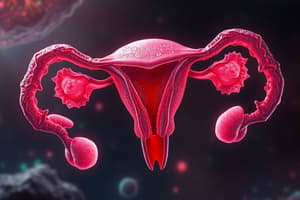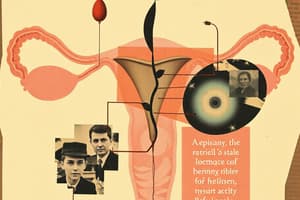Podcast
Questions and Answers
What is the initial stage of oogenesis called?
What is the initial stage of oogenesis called?
- Follicular phase
- Primary oocyte stage (correct)
- Ovulatory stage
- Secondary oocyte stage
Which hormone primarily regulates the ovarian cycle?
Which hormone primarily regulates the ovarian cycle?
- Insulin
- Luteinizing hormone (LH) (correct)
- Testosterone
- Progesterone
What structure does the egg pass through after ovulation?
What structure does the egg pass through after ovulation?
- Fallopian tube (correct)
- Cervix
- Vagina
- Uterus
What is the primary factor influencing a woman's biological clock?
What is the primary factor influencing a woman's biological clock?
What is menopause characterized by?
What is menopause characterized by?
Which of the following describes a common birth control method?
Which of the following describes a common birth control method?
During fertilization, which part of the sperm is responsible for penetrating the egg's outer layer?
During fertilization, which part of the sperm is responsible for penetrating the egg's outer layer?
In terms of hormonal control, which hormone surges to trigger ovulation?
In terms of hormonal control, which hormone surges to trigger ovulation?
What role do intrauterine membranes play during pregnancy?
What role do intrauterine membranes play during pregnancy?
Which stage is considered the first point of development after fertilization?
Which stage is considered the first point of development after fertilization?
Which organs are primarily involved in the female reproductive system's role in fertilization?
Which organs are primarily involved in the female reproductive system's role in fertilization?
What triggers the completion of meiosis II in the secondary oocyte?
What triggers the completion of meiosis II in the secondary oocyte?
What is atresia in the context of female reproductive health?
What is atresia in the context of female reproductive health?
Which layer of the uterus is responsible for contractions during childbirth?
Which layer of the uterus is responsible for contractions during childbirth?
At what stage does oogenesis stop during a female's development before puberty?
At what stage does oogenesis stop during a female's development before puberty?
Which of the following structures partially wraps around the ovaries to catch the oocyte after ovulation?
Which of the following structures partially wraps around the ovaries to catch the oocyte after ovulation?
Which phase of ovarian changes lasts from day 1 through 13?
Which phase of ovarian changes lasts from day 1 through 13?
How many primary oocytes does a female have at birth?
How many primary oocytes does a female have at birth?
Which structure is primarily responsible for the implantation of the embryo?
Which structure is primarily responsible for the implantation of the embryo?
What is the main hormonal trigger for ovulation?
What is the main hormonal trigger for ovulation?
Which of the following statements about oogenesis is incorrect?
Which of the following statements about oogenesis is incorrect?
During which phase is the corpus luteum formed?
During which phase is the corpus luteum formed?
What is the main purpose of the corpus luteum during the luteal phase?
What is the main purpose of the corpus luteum during the luteal phase?
Which part of the vagina opens between the labia?
Which part of the vagina opens between the labia?
What occurs to the majority of follicles during ovarian development?
What occurs to the majority of follicles during ovarian development?
What role does increased estradiol play during the follicular phase?
What role does increased estradiol play during the follicular phase?
What hormonal changes trigger the sloughing of the endometrium?
What hormonal changes trigger the sloughing of the endometrium?
Oral contraceptives primarily mimic which hormone to prevent ovulation?
Oral contraceptives primarily mimic which hormone to prevent ovulation?
What effect do high levels of estradiol and progesterone have on FSH and LH secretion?
What effect do high levels of estradiol and progesterone have on FSH and LH secretion?
What does the rhythm method of contraception rely on for its effectiveness?
What does the rhythm method of contraception rely on for its effectiveness?
What initiates the follicular phase of the ovarian cycle?
What initiates the follicular phase of the ovarian cycle?
What characterizes menopause?
What characterizes menopause?
How long does progesterone peak after ovulation?
How long does progesterone peak after ovulation?
What is the outcome of the LH surge?
What is the outcome of the LH surge?
What happens to FSH and LH levels in menopausal women?
What happens to FSH and LH levels in menopausal women?
Which of the following is a characteristic symptom of menopause?
Which of the following is a characteristic symptom of menopause?
What is the focus of atresia in follicle development?
What is the focus of atresia in follicle development?
What role do subdermal hormonal implants play in contraception?
What role do subdermal hormonal implants play in contraception?
What precaution is typically taken during the use of oral contraceptives?
What precaution is typically taken during the use of oral contraceptives?
What is a common risk factor for women after menopause?
What is a common risk factor for women after menopause?
Flashcards
What states have no sales tax?
What states have no sales tax?
Alaska, Delaware, Montana, New Hampshire, and Oregon do not have sales tax.
What states are exempting essential hygiene products?
What states are exempting essential hygiene products?
Connecticut, Florida, Illinois, Maryland, Massachusetts, Minnesota, New Jersey, New York, Nevada, and Pennsylvania have exempted essential hygiene products from sales tax.
Ovaries
Ovaries
The female gonads where oocytes and sex steroids are produced.
Uterine (Fallopian) Tubes
Uterine (Fallopian) Tubes
Signup and view all the flashcards
Uterus
Uterus
Signup and view all the flashcards
Endometrium
Endometrium
Signup and view all the flashcards
Myometrium
Myometrium
Signup and view all the flashcards
Perimetrium
Perimetrium
Signup and view all the flashcards
Vagina
Vagina
Signup and view all the flashcards
Clitoris
Clitoris
Signup and view all the flashcards
Homologous Structures
Homologous Structures
Signup and view all the flashcards
Oogonia
Oogonia
Signup and view all the flashcards
Primary Oocytes
Primary Oocytes
Signup and view all the flashcards
Atresia
Atresia
Signup and view all the flashcards
What are the three phases of the ovarian follicular cycle?
What are the three phases of the ovarian follicular cycle?
Signup and view all the flashcards
Follicular Phase
Follicular Phase
Signup and view all the flashcards
Ovulation
Ovulation
Signup and view all the flashcards
Luteal Phase
Luteal Phase
Signup and view all the flashcards
What role does FSH play in the follicular phase?
What role does FSH play in the follicular phase?
Signup and view all the flashcards
How does estradiol influence the follicular phase?
How does estradiol influence the follicular phase?
Signup and view all the flashcards
What is the role of LH in the follicular phase?
What is the role of LH in the follicular phase?
Signup and view all the flashcards
What is the relationship between FSH and LH in the follicular phase?
What is the relationship between FSH and LH in the follicular phase?
Signup and view all the flashcards
What happens to the follicle after ovulation?
What happens to the follicle after ovulation?
Signup and view all the flashcards
Corpus Luteum
Corpus Luteum
Signup and view all the flashcards
Ovarian cycle
Ovarian cycle
Signup and view all the flashcards
Hormonal Birth Control
Hormonal Birth Control
Signup and view all the flashcards
Oral Contraceptives
Oral Contraceptives
Signup and view all the flashcards
Intrauterine Devices (IUDs)
Intrauterine Devices (IUDs)
Signup and view all the flashcards
Menopause
Menopause
Signup and view all the flashcards
Estradiol
Estradiol
Signup and view all the flashcards
FSH and LH
FSH and LH
Signup and view all the flashcards
Oogenesis Stages
Oogenesis Stages
Signup and view all the flashcards
Ovulated Egg Journey
Ovulated Egg Journey
Signup and view all the flashcards
Ovarian Cycle Hormones
Ovarian Cycle Hormones
Signup and view all the flashcards
External Influence on Cycle
External Influence on Cycle
Signup and view all the flashcards
Biological Influence on Fertility
Biological Influence on Fertility
Signup and view all the flashcards
Birth Control Methods
Birth Control Methods
Signup and view all the flashcards
Fertilization
Fertilization
Signup and view all the flashcards
Development Stages
Development Stages
Signup and view all the flashcards
Hormonal Control in Development
Hormonal Control in Development
Signup and view all the flashcards
Study Notes
Learning Objectives
- Describe the stages of oogenesis.
- Trace an ovulated egg through the female reproductive tract, identifying structures and their functions.
- Draw a diagram explaining the ovarian cycle, including involved hormones and timing.
- Explain the external hormonal influences on the female reproductive cycle and biological influences on female fertility.
- Detail available birth control options and their mechanisms.
- Define menopause and its process.
- Detail the process of fertilization.
- Describe embryonic development from zygote to birth, focusing on controlling hormones.
- Explain the relationship between the mother and fetus concerning intrauterine membranes.
- Describe labor and delivery processes and related hormones.
Ovarian Cycle and Oogenesis
- Oogenesis is the process of egg production.
- Oogonia begin meiosis in the fetus but stop at prophase I.
- At birth, an ovary contains millions of primary oocytes (arrested at prophase I) destined for ovulation.
- By puberty, this number greatly diminishes.
- Only about 400 oocytes will mature and ovulate during a woman's reproduction years.
- Ovulation involves follicle maturation, release of a secondary oocyte, and subsequent hormonal changes.
- The ovarian cycle is controlled by FSH and LH, triggering oocyte maturation and release.
Fertilization
- Fertilization occurs when sperm penetrates the secondary oocyte.
- A zygote is formed, which undergoes cleavage and cell division.
- This develops into a morula, a solid ball of cells.
- The morula forms a blastocyst, which consists of an outer layer (trophoblast) and an inner cell mass.
- Implantation is the process where the blastocyst attaches to the uterine wall.
- Human chorionic gonadotropin (hCG) is secreted by the trophoblast, maintaining the corpus luteum and ensuring progesterone production.
Pregnancy
- Implantation marks the beginning of pregnancy.
- Embryo development occurs from the inner cell mass.
- The corpus luteum produces progesterone, supporting the pregnancy.
- The placenta gradually takes over progesterone and estrogen production.
- Hormonal interaction between mother and fetus maintains pregnancy and development.
Labor and Delivery
- Labor is a series of uterine contractions.
- The hypothalamus regulates oxytocin release from the posterior pituitary.
- Oxytocin stimulates stronger uterine contractions.
- Prostaglandins are produced by the uterus, intensifying contractions.
- The fetus descents and pressure on the cervix initiates oxytocin release and further contractions.
- A positive feedback loop ensures expulsion of the fetus and the placenta.
Lactation
- Mammary glands contain lobules with alveoli.
- Alveoli generate milk for the nursing infant.
- Prolactin controls milk secretion.
- Oxytocin causes smooth muscles to contract, expelling milk ("milk ejection reflex").
Menopause
- Menopause marks cessation of ovarian activity and menstrual cycles.
- Reduction in estrogen and progesterone occurs.
- This leads to various physiological changes.
- Menopause typically occurs around age 50.
- Menopausal women are at higher risk for osteoporosis due to the lost ability in estrogen production.
Contraceptive Methods
- Various methods prevent pregnancy by inhibiting ovulation, preventing fertilization, or physically preventing pregnancy occurrence.
- Oral contraceptives mimic progesterone to block ovulation.
- Long-acting reversible contraceptives (LARCs) impede fertilization or ovulation for an extended period.
- The rhythm method tries to avoid intercourse around ovulation time.
Studying That Suits You
Use AI to generate personalized quizzes and flashcards to suit your learning preferences.




